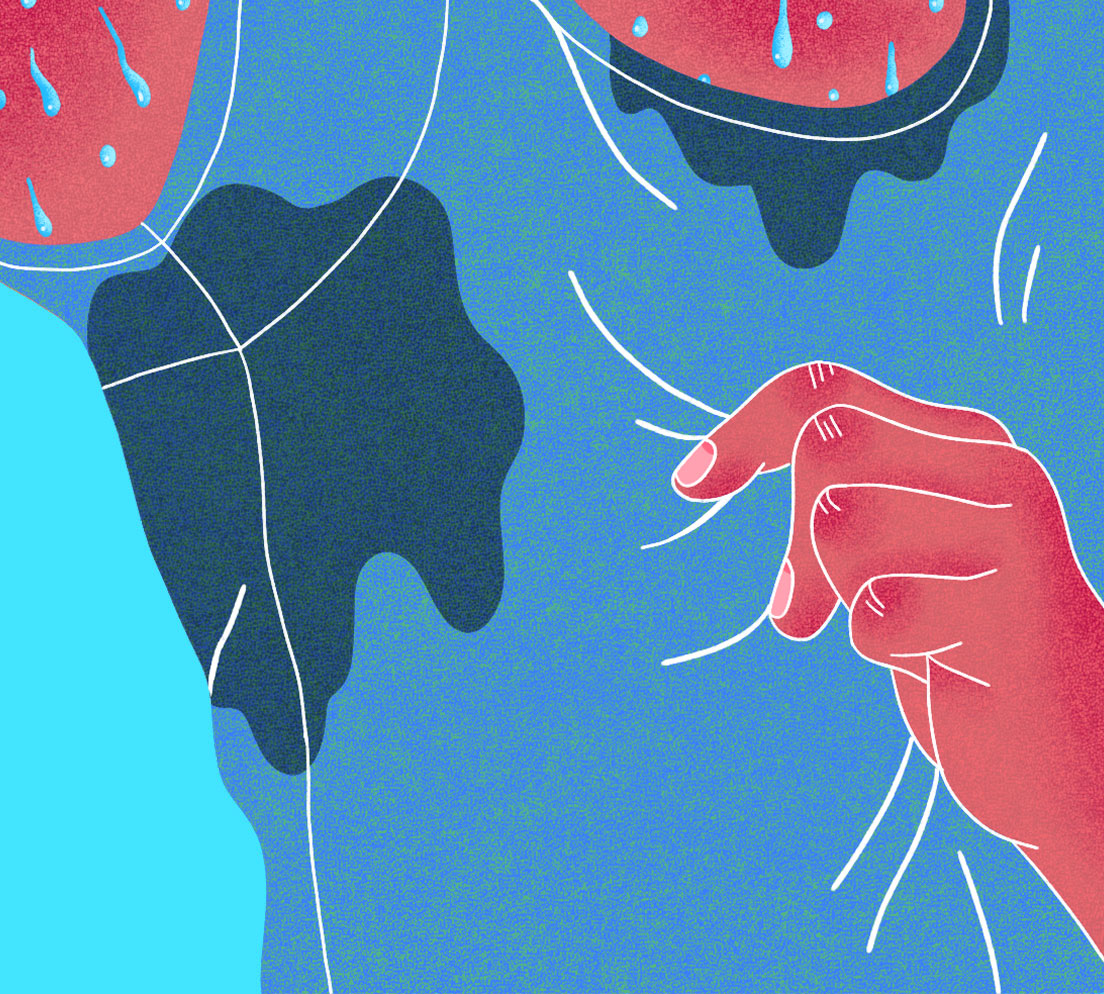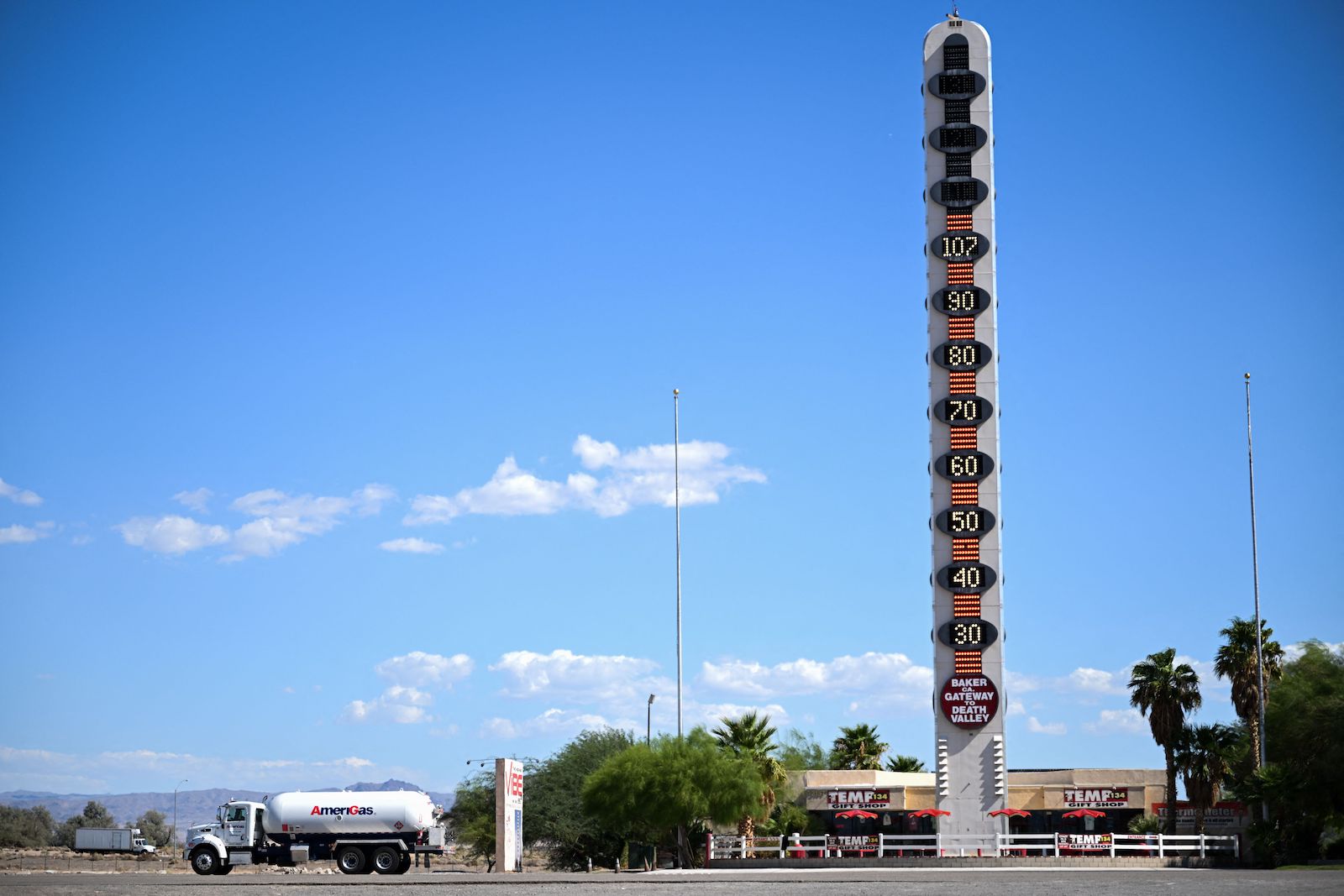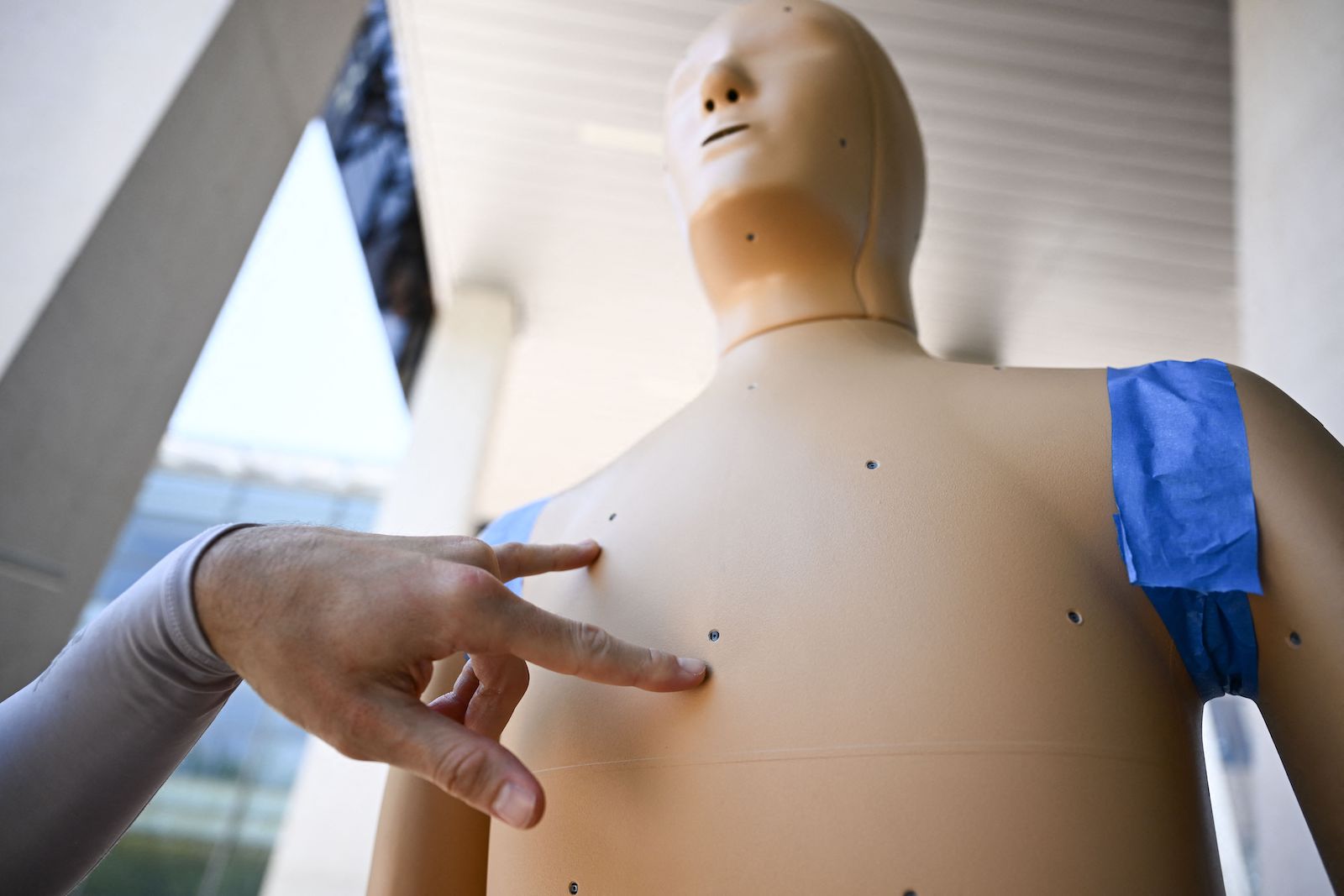This story is a part of Report Excessive, a Grist sequence inspecting excessive warmth and its affect on how — and the place — we dwell.
Below the relentless solar in Africa, the birthplace of humanity, each residing factor needed to discover a option to beat the warmth. Lions rested within the shade, termites constructed big air flow mounds, and elephants developed big ears that would flap like followers. Round 2 million years in the past, our ancestors perfected the weirdest approach of all of them: pushing water from inside our our bodies to outdoors, a present for enduring sweltering temperatures.
Different animals can sweat a bit, however not like us. Working round within the warmth, an individual can shed greater than two gallons of water every day, draining considered one of life’s valuable assets at a speedy tempo. Because the physique tries to chill down, blood vessels widen, redirecting scorching blood from the core of your physique towards the floor. In tandem, sweat glands pump water, drawn from that blood, onto your pores and skin. When these tiny beads evaporate, they carry warmth off the physique and into the air.
“It’s essential to being human,” mentioned Yana Kamberov, a geneticist finding out the evolution of sweat on the College of Pennsylvania. “It’s one thing that differentiates us from each different animal on the planet” — proper up there with our outsized brains. The common particular person has between 2 and 4 million sweat glands of their pores and skin, at 10 occasions the density of a chimpanzee’s, considered one of our closest residing kinfolk. For people, sweat proved much more helpful than protecting fur; our thick coat dwindled into peach fuzz to permit water to evaporate extra effectively.
Our organic sprinkler programs are actually being put to the take a look at. This summer season was not simply the most well liked three consecutive months on file, however the hottest on Earth in 125,000 years. Phoenix spent 31 days in a row with a excessive of 110 levels F or above. Throughout the Northern Hemisphere, from continent to continent, warmth data fell at an alarming tempo, with Morocco and China setting all-time highs above 120 levels F. The swampy Gulf Coast warmth soared as excessive as 115 levels F, rewriting data for Houston and New Orleans. Even South America, within the throes of winter, noticed unbelievable warmth: A city within the Chilean Andes topped 100 levels F — one other all-time excessive.
It’s attending to the purpose that life is harmful with out air-conditioning. If a widespread energy outage hit Phoenix throughout a warmth wave and lasted for days, it might kill 1000’s and ship half town to the emergency room, in keeping with a current examine. And the soupy warmth within the Gulf Coast comes with a problem of its personal: Tremendous scorching and humid air makes it exhausting for sweat to evaporate, as a result of the setting is already thick with water molecules, which suggests extra warmth stays trapped contained in the physique, elevating the chance of getting cooked from the within out.
“Dying from a warmth wave is sort of a horror film with 27 endings that you may select from,” mentioned Camilo Mora, a local weather scientist on the College of Hawaiʻi at Mānoa, who has cataloged 27 completely different ways in which warmth can result in organ failure and dying.
As blood will get shunted towards the pores and skin, as an example, it strains the guts and deprives the mind and intestine of oxygen, resulting in coronary heart assaults and different grisly outcomes from widespread irritation and clotting. Extended sweating can even trigger dehydration, generally inducing kidney failure. Warmth has so some ways to kill you that it’s simply the deadliest of all climate disasters Individuals face. In 2017, Mora and colleagues discovered that 30 % of the world’s inhabitants was already uncovered to probably lethal warmth for 20 days or extra every year.
Given how essential perspiration is for survival, you’d assume that researchers would have the science of sweat all discovered by now, however there are nonetheless open questions. Precisely how scorching is just too scorching for the human physique? How necessary is humidity? And why aren’t we extra grateful for sweat? Its nasty fame for making you stink belies the truth that it’s basically a built-in life jacket that will help you journey out record-breaking warmth waves.
Feeling moist and sticky is a lot better than the choice — dying by warmth stroke. “I feel it’s humorous that people have this monumental taboo a couple of organic operate that’s in the end going to assist us survive local weather change,” mentioned Sarah Everts, the writer of The Pleasure of Sweat.

Lethal warmth can hit mainly wherever, catching individuals off-guard. Take the record-breaking temperatures that swept over Europe final summer season, sending the thermostat hovering above 100 levels F throughout the continent, leading to greater than 61,000 deaths. Our our bodies can acclimatize to warmth over a interval of weeks, giving us the power to sweat extra. However temperatures can skyrocket rapidly — in February this 12 months, thermostats in Washington, D.C., jumped nearly 30 levels in a day, from a excessive of 53 levels F at some point to 81 the subsequent. These sorts of leaps are lots for our our bodies to deal with, making warmth waves in cooler climates particularly lethal.
Even in international locations like Pakistan, the place persons are well-adapted to warmth, sweltering temperatures are taking casualties. “With local weather change, issues are simply going past limits of adaptation,” mentioned Fahad Saeed, a scientist with the worldwide local weather coverage institute Local weather Analytics, who is predicated in Islamabad. “Whenever you’re witnessing that on this a part of the world, it actually sort of tells you one thing goes past regular, as a result of the persons are acclimatized to this sort of climate, and nonetheless they’re dying.”
A measure known as the “wet-bulb temperature,” which mixes warmth and humidity with daylight and wind velocity, is used to calculate the brink at which a wholesome human physique can not survive. Invented by the U.S. army within the Nineteen Fifties after recruits stored collapsing from warmth sickness at a camp in South Carolina, it’s decided by protecting a thermometer in a humid fabric and swinging it via the air to hurry up evaporation. The theoretical level at which no quantity of sweating may help you is regarded as six hours of publicity to a wet-bulb temperature of 35 levels Celsius, or 95 levels Fahrenheit. That interprets to 95 levels in full humidity, for instance, or 115 levels at 50 % humidity.
In recent times, elements of Pakistan and the Arabian Peninsula have already briefly crossed this scary threshold. And extra warmth will come, bringing elements of Mexico’s coasts and extra of South Asia into the hazard zone. Worryingly, local weather change can be driving up the moisture content material of the air, particularly within the tropics.
Newer analysis means that the restrict is perhaps even decrease than 35 levels C. In a examine final 12 months at Penn State College, younger individuals volunteered to topic themselves to uncomfortably scorching circumstances in a lab. Members swallowed telemetry drugs that monitored their core physique temperature and sat in a managed chamber, transferring simply sufficient to imitate on a regular basis actions like cooking and consuming. When the physique fails to stabilize its core temperature, issues begin to spiral uncontrolled: In excessive circumstances, warmth stroke can set in inside 10 to fifteen minutes. The researchers discovered that the higher restrict of security, primarily based on when the contributors’ core temperatures began rising, was possible nearer to a wet-bulb temperature of 31 levels C, or 88 levels F.
And that’s for wholesome individuals. Elements like age, sickness, and physique dimension change the maths. Individuals over the age of 60, who account for an estimated 80 % of the 12,000 heat-related deaths in the USA every year, usually have well being circumstances that make warmth extra harmful. What’s extra, as individuals become old, their sweat glands deteriorate, undermining their potential to chill down. Some antipsychotic medicines have a aspect impact of suppressing sweating, presumably considered one of many the reason why these identified with schizophrenia are significantly weak to dying within the warmth.
The truth is that most individuals don’t take all the required steps to remain cool throughout a warmth wave, like looking for shade or consuming a number of chilly water — another excuse {that a} pragmatic “hazard zone” for temperatures begins properly beneath 35 levels C. Earlier this month, researchers from the College of Oxford and the Woodwell Local weather Analysis Heart in Massachusetts analyzed the new and humid circumstances underneath which the human physique begins to overheat until particular actions to chill down are taken. They discovered that underneath our present local weather, 8 % of the land on Earth will meet this threshold a minimum of as soon as a decade. That will improve to 1 / 4 if international temperatures heat 2 levels C above the preindustrial common, the quantity we are able to count on if present and deliberate fossil gas initiatives are carried via.

Nonetheless, there’s a debate round how a lot humidity issues in well being outcomes, mentioned Jane Baldwin, an Earth programs science professor on the College of California, Irvine. Humidity isn’t exhibiting up as a key driver of deaths in real-world epidemiological information such as you’d count on primarily based on theories about wet-bulb temperature. Baldwin just lately coauthored a examine making an attempt to elucidate this discrepancy. One clarification could possibly be that epidemiological information tends to return from cooler elements of the world, like Europe and the USA, whereas information is proscribed from tropical international locations like India, Ghana, and Brazil, the place the hyperlink between humidity and dying would possible be strongest. Nailing down a solution to this query would assist scientists make extra correct predictions about how local weather change will have an effect on well being, Baldwin mentioned.
The other excessive — dry air — might current its personal set of issues. In arid circumstances, sweat evaporates in a short time. That’s nice for cooling off, however sweat manufacturing has a restrict, mentioned Ollie Jay, a well being professor on the College of Sydney in Australia. At relaxation, it’s exhausting to sweat greater than a liter per hour, he mentioned, however once you’re exercising, nearer to a few liters can pour out of your physique in an hour. For those who managed to succeed in that time of most sweatiness in dry warmth, you then wouldn’t be capable to sweat sufficient to chill down. “Most local weather fashions for assessing future heat-stress threat assume that the physique has a limiteless capability to provide sweat,” Jay mentioned, nearly actually resulting in overestimates for what people can deal with in scorching, arid climates.
One other unknown is simply how a lot early publicity to warmth adjustments our potential to sweat. One concept is that being uncovered to excessive temperatures within the first two years of life can activate extra sweat glands; we’re born with roughly the identical variety of sweat glands, however not all of them activate and begin pumping water. Consequently, individuals born in scorching locations might need extra energetic sweat glands than these born in chilly climates.
It raises questions of whether or not those that spend their youth avoiding sweat-soaked garments by hiding in artificially cooled buildings could possibly be much less ready for all times on an more and more scorching planet. “Think about, in the event you elevate your infants purely in air-con,” Kamberov mentioned, “then in a hotter world, how able to adapting will they be?”

Sweat is actually saving our lives all summer season lengthy — although you most likely don’t get pleasure from it. Everts, the writer of The Pleasure of Sweat, speculates that it violates our need to be in management. Sweat pours out of us involuntarily: We are able to’t maintain it in or delay it with willpower, not like burps or farts. “When your physique will get the cooldown directive, these pores open, and the sweat pours out,” Everts mentioned, “and there’s completely nothing you are able to do to regulate that, proper?”
It doesn’t assist {that a} sweaty particular person is commonly a smelly one, the curse of locker rooms in every single place. Sweat itself is odorless — it’s largely simply water — however when it mixes with micro organism in your pores and skin, it could elevate a stench. There are two kinds of sweat glands: Eccrine glands, essentially the most outstanding, are chargeable for preserving your temperature in examine and located everywhere in the physique — significantly in your brow, palms, and the bottoms of your toes. Apocrine glands in furry areas just like the armpits and groin change into energetic throughout puberty, secreting a thicker, protein-rich sweat that micro organism convert into that embarrassing aroma. Plugging your armpit pores with antiperspirant, then, received’t have an effect on your potential to chill down: There are many different escape routes in your pores and skin.
Within the olden days, individuals utilized fragrance and talcum powder to attempt to cowl up the odor of B.O. However they had been so used to it that by the point antiperspirants and deodorants got here onto the market across the flip of the twentieth century — the previous geared toward blocking sweat pores, the latter at combating odor-producing micro organism — hardly anybody needed to purchase them. That posed an issue for the producers. So in 1919, a copywriter named James Younger who was working for the antiperspirant firm Odorono (odor, oh no!) “put the concern of sweat in Individuals,” Everts mentioned. One journal advert with the headline “Probably the most humiliating second in my life” featured a younger girl overhearing that nobody would dance together with her as a result of she suffered “frightfully from perspiration.” The thought was not simply to make individuals conscious of their stink, however to make them afraid it will cease them from discovering love or a good job. “I simply want individuals had been much less mortified by sweat,” Everts mentioned.
The advertising marketing campaign was an enduring success, even a century later. Final 12 months, the worldwide deodorant market was valued at $24 billion, and it’s on observe to develop to $37 billion by the top of the last decade, partly due to international warming, in keeping with the market analysis agency Fortune Enterprise Insights.

Immediately, some cultures are extra matter-of-fact about sweat than others. In Pakistan, it’s merely a reality of life, Saeed mentioned. Nonetheless, extreme sweating is frowned upon mainly in every single place. “What can prevent just isn’t culturally accepted,” mentioned Mora, the College of Hawaiʻi scientist. “I can not think about wherever on this planet the place you wish to be hugged by a sweaty particular person.”
How sweaty you’re isn’t in your management — however what you put on is. Scorching, humid climates name for extra uncovered pores and skin, making it simpler in your sweat to evaporate; maybe counterintuitively, free, lengthy sleeves and pants enable you to reap the advantages of sweat in arid climates, preserving the water from evaporating too rapidly and on the similar time blocking daylight. Konrad Rykaczewski, a professor of engineering at Arizona State College, is researching the best way to assist design clothes that maximizes the effectiveness of sweating. He says that scientists nonetheless don’t perceive lots about sweat on the dimensions that actually issues for clothes design.
“The query is, how a lot of the sweat we produce truly goes to cooling us?” Rykaczewski mentioned. Sweating profusely isn’t serving to anybody — sweat that drips off your brow is actually wasted water, because it didn’t evaporate off you. By the identical token, trapping a bunch of sweat beneath a hazmat swimsuit might depart you inclined to warmth diseases. Counterintuitively, even materials that wick sweat can find yourself stealing it away out of your pores and skin and losing it, Rykaczewski mentioned. When that water evaporates, it’ll cool the material and the air between the material and your pores and skin, as a substitute of your physique immediately.
Rykaczewski’s analysis is concentrated on understanding how warmth impacts the human physique in the true world, one thing that’s troublesome to check. “Nobody’s measuring somebody that’s going to get heatstroke, proper?” Rykaczewski mentioned. “That’s not moral.”

So, instead of dwell people, he and his colleagues at Arizona State have developed a sweating robotic, technically known as a “thermal model,” that simulates human responses to super-hot temperatures. The robotic — named ANDI for “Superior Newton Dynamic Instrument” — takes frequent journeys into the scorching Arizona warmth, outfitted with sensors, an inner cooling system, in addition to pores for sweating. One distinctive factor about ANDI is that it could symbolize anybody. Rykaczewski can modify this system to simulate how an individual would possibly climate the warmth, calculating how components like age, physique dimension, or drug use would possibly have an effect on the physique’s response in numerous conditions. And all of it comes on the low value of $650,000. “We mainly are creating the costliest option to measure warmth impacts on people,” Rykaczewski joked.
ANDI is actually a crash take a look at dummy for a warmer planet. Our our bodies are up towards warmth that threatens to render our dampness ineffective. People have been sweating for tons of of 1000’s of years, and it’s core to who we’re. However to actually perceive it? For that, we would have liked to construct a robotic.




